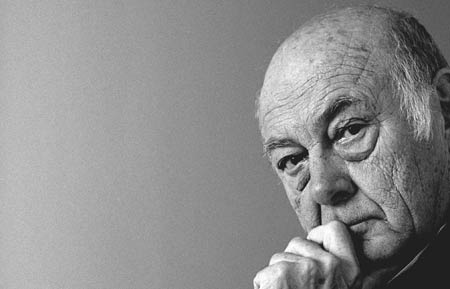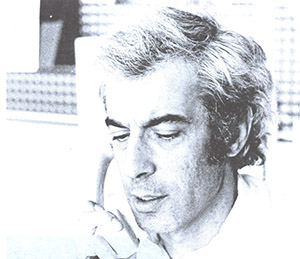<Back to Index>
- Graphic Designer Alan Gerard Fletcher, 1931
- Graphic Designer Daniel Gil Pila, 1930
- Illustrator and Graphic Designer Bob Gill, 1931
PAGE SPONSOR

Alan Gerard Fletcher (27 September 1931 – 21 September 2006) was a British graphic designer. In his obituary, he was described by The Daily Telegraph as "the most highly regarded graphic designer of his generation, and probably one of the most prolific".
Fletcher was born in, Kenya, where his father was a civil servant. He returned to England aged 5 with the rest of his family, when his father was terminally ill. He lived with his grandparents in Shepherd's Bush in West London, before being evacuated in 1939 to Christ's Hospital in Horsham.
He studied at the Hammersmith School of Art from 1949, then at the Central School of Art, where he studied under Anthony Froshaug and befriended Colin Forbes, Theo Crosby, Derek Birdsall and Ken Garland. After a year teaching English in Barcelona, he returned to London to study at the Royal College of Art from 1953 to 1956, where he met Peter Blake, Joe Tilson, Len Deighton, Denis Bailey, David Gentleman and Dick Smith.
He married Paola Biagi, an Italian national, in 1956 (they met with a
heated discussion about if orange and pink were a good or bad color
pair). He then took up a scholarship to study at the School of
Architecture and Design at Yale University, under Alvin Eisenman, Norman Ives, Herbert Matter, Bradbury Thompson, Josef Albers and Paul Rand. He visited Robert Brownjohn, Ivan Chermayeff and Tom Geismar in New York, became friends with Bob Gill, and was commissioned by Leo Lionni to design a cover for Fortune magazine in 1958. After a visit to Venezuela, he returned to London in 1959, having worked briefly for Saul Bass in Los Angeles and Pirelli in Milan.
He founded the design firm Fletcher / Forbes / Gill with Colin Forbes and Bob Gill in 1962. An early product was their 1963 book Graphic Design: A Visual Comparison.
Clients included Pirelli, Cunard, Penguin Books and Olivetti. Gill left the partnership in 1965 and was replaced by Theo Crosby, so the firm became Crosby / Fletcher / Forbes. Two new partners joined, and the partnership evolved into Pentagram in 1972, with Forbes, Crosby, Kenneth Grange and Mervyn Kurlansky, with clients including Lloyd's of London and Daimler Benz. Much of his work is still in use: a logo for Reuters made up of 84 dots, which he created in 1965, was retired in 1992, but his 1989 "V&A" logo for Victoria and Albert Museum, and his "IoD" logo for the Institute of Directors remain in use. In last years he designed the logo for the Italian School of Architecture "Facolta` di Architettura di Alghero", (University of Sassari).
He left Pentagram in 1992, and worked from the home in Notting Hill that he had occupied since the early 1960s, where he was assisted by his daughter Raffaella Fletcher, Leah Klein and Sarah Copplestone, and worked for new clients, such as Novartis. Much of his later work was as art director for the publisher Phaidon Press, which he joined in 1993. For him, life and work were inseparable: "Design is not a thing you do. It's a way of life." (quoted in his obituary in The Times). He would continue working, even on holiday, drawing on a notepad with a pencil.
A book of his designs, Beware Wet Paint, was published by Jeremy Myerson in 1994. Fletcher also wrote several books about graphic design and visual thinking, most notably The Art of Looking Sideways (2001), which had taken him 18 years to finish.
An exhibition of his life's work was displayed at the Design Museum in London between 11 November 2006 until 18 February 2007, alongside the posthumous publication of a book, Picturing and Poeting. The exhibition went on tour in 2008. It was installed at the Ginza Graphic Gallery in Tokyo between the 9th and 31st of May 2008, and was installed at the Pitzhanger Manor Gallery in Ealing, West London, between 14 November 2008 and 3 January 2009.
He won the Prince Philip Prize for Designer of the Year, was President of the Designers and Art Directors Association in 1973 and International President of the Alliance Graphique Internationale from 1982 to 1985. He was elected to the Hall of Fame of the New York Art Directors Club in 1994, was a senior fellow of the Royal College of Art in 1989 and became an honorary fellow of the London Institute in 2000.
The December 2006 limited edition cover of Wallpaper* magazine featured one of his last works omitting his calligraphic signature in the compliments slip accompanying his completed work for he was too frail by then.
He died of cancer in London, and is survived by his wife and daughter.

Daniel Gil Pila (February 17, 1930 – November 14, 2004), was one of the leading Spanish graphic designers of the 20th century.
Born in Santander, Daniel Gil studied in the Academy of Fine Arts of Madrid. In the early 50's he attended the Ulm School of Design, where he was a disciple of Otl Aicher.
Back in Spain, Gil entered as graphic designer in the Hispavox recording house, becoming shortly its Art director. He then worked for two other record labels, namely the Spanish branches of Ariola and RCA.
In 1966 Gil moved to Alianza Editorial publishing house, where along almost thirty years he produced more than 4,000 book covers that made him the best known and recognized Spanish graphical designer.
In his last years, the Parkinson disease from which he suffered prevented him from working with full control of his faculties.

Bob Gill (b. Brooklyn, New York, January 17, 1931), American illustrator and graphic designer. He played the piano at summer resorts in the Catskill Mountains, New York, to pay his school tuition. He attended the Philadelphia Museum School of Art (1948 – 1951), Pennsylvania Academy of Fine Arts (1951), City College of New York (1952, 1955). When he graduated he became a professional graphic designer in New York City. In 1960 after an interview in a New York hotel room for a job in London, he moved to the UK to work for Charles Hobson, at a "hack advertising agency", according to Gill, which was later sold to Grey Advertising (now Grey Global Group).
April Fool's Day, 1962, Gill, Alan Fletcher and Colin Forbes established Fletcher / Forbes / Gill design studio, the forerunner of Pentagram. More than 100,000 copies of the partnership’s book, Graphic Design: Visual Comparisons (New York, 1963), were sold. F/F/G soon outgrew their small studio and moved into a huge Victorian former gun factory on a canal. They started the Designers and Art Directors Association D&AD and opened a second office in Geneva.
In 1967, Gill left the partnership and assumed independent freelancing again, including teaching, film making and writing children’s books. He returned to New York in 1975 to write and design Beatlemania, the largest multimedia musical up to that time on Broadway, on which he worked with Robert Rabinowitz. He also proposed a peace monument for Times Square, Gill wanted to collect military junk from all over the world, pile it 40 feet high, spray it matte black, and mount it on a block of white marble. The New York City Fine Arts Commission did not like the idea.
For his graphic design work, Gill won a number of awards, sold illustrations to Esquire, Architectural Forum, Fortune, Seventeen, and The Nation magazines and illustrated children’s books and designed film titles. He also designed for Apple Corps records, Rainbow Theater, Pirelli, Nestlé, CBS, Universal Pictures, Joseph Losey, Queen (now Harpers & Queen), High Times magazines and the United Nations. He was elected to the New York Art Directors Club Hall of Fame in 1991 and the Designers and Art Directors Association of London presented him with their Lifetime Achievement Award.
He later lived in New York with his wife, New York Public Radio's Sara Fishko, their son Jack, and their daughter Kate.